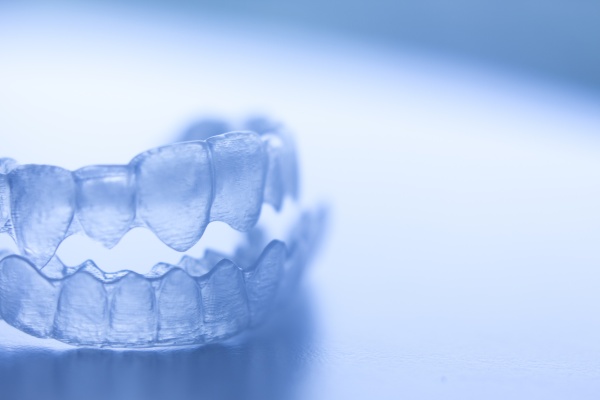Why You Need to Keep Your Invisalign Trays Clean

The growing need for straighter teeth and a good-looking smile is why more people are turning to treatments such as Invisalign®. After getting the aligner trays, it is important to clean them properly. In this article, you will learn about the importance of cleaning Invisalign trays and a few care tips.
The importance of cleaning Invisalign trays
Just as brushing the teeth every night is important, knowing how to clean Invisalign trays is vital for oral health. First, one of the reasons that people prefer Invisalign over braces is the invisibility or discreetness. However, they need to be cleaned regularly to maintain the invisibility; otherwise, stains will form over the trays and they will start to yellow.
Good oral hygiene practices not only keep the aligners trays invisible but also help prevent bad breath. Food particles can get trapped in the Invisalign trays. This can encourage the spread of bacteria, which in turn, causes bad breath. Regular cleaning can help keep the mouth smelling good.
Cleaning the trays helps prevent tooth decay. Decay develops when food particles accumulate between the teeth and on the aligners. Bacteria feast on the food debris, causing plaque. Plaque, in turn, causes cavities or tooth decay and gum disease. These oral issues are uncomfortable and costly to treat and can extend treatment duration.
How to clean the Invisalign tray
Food particles can get trapped between the teeth. Using the trays without brushing the teeth can prevent saliva from cleaning the mouth naturally. Keeping the teeth clean through brushing and flossing keeps the Invisalign trays clean as well.
Every time the tray comes off the teeth, they will need to be cleaned properly. Soaking and rinsing the tray with ordinary water will not be enough to prevent bacteria accumulation. Instead, a clear, scentless soap that will not tint the aligner is advisable. That way, one can wear the trays without getting a weird taste. Denture cleaners and Invisalign cleaning crystals can also be used.
When cleaning the trays, hot water should never be used for disinfection. The aligners are created with thermoplastic materials that will cause them to deform in hot water. Cold water, on the other hand, can cause the trays to contract. Room-temperature water is preferable. Toothpaste should never be used because it can cause staining.
The Invisalign aligners need to be worn for at least 22 hours per day. The remaining two hours are meant for soaking. The trays should soak in warm water containing cleaning crystals for about 20 minutes. Patients can brush the trays afterward and dry them properly to prevent moisture from causing stains. The cleaning should be done daily to keep the trays free of dirt and stains.
In conclusion
If you have recently started your Invisalign journey, you need to be proactive about oral hygiene and cleaning. If you need additional information, be sure to ask the general dentist.
Request an appointment here: https://www.oaklandsmiles.com or call Oakland Smile Dentistry at (510) 256-5117 for an appointment in our Oakland office.
Check out what others are saying about our dental services on Yelp: Invisalign in Oakland, CA.
Related Posts
Invisalign® gets you the straight smile you have always wanted without having to deal with ugly metal braces and the countless stares people who wear braces often find themselves dealing with. Invisalign therapy uses transparent plastic trays to gradually push a person’s teeth towards a better alignment. These transparent trays are barely visible when worn,…
Invisalign® aligners are one of the options you might encounter if you are considering teeth straightening. It is a significant step that could ensure lifelong confidence and a healthy oral cavity. Away with the metal braces that use brackets and wires, Invisalign aligner uses a system of transparent plastic trays to straighten the teeth, removing…
General dentists state that bruxism is a condition that involves the grinding of the top and bottom arches of teeth. The act often happens at night while a person is asleep, making it involuntary. However, some individuals are also known to grind their teeth during the day as well. Although teeth grinding does not sound too…
A dental restoration is required to restore tooth structure lost due to tooth decay or injury. Dental restorations fix teeth that have been cracked, chipped, fractured or have cavities. Various restoration techniques are intended to restore various degrees of damage. This article reviews different approaches to repairing damaged teeth.There are two kinds of dental restorations:…
